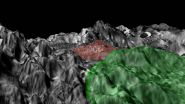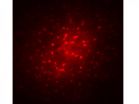(Press-News.org) This news release is available in Japanese.
Researchers at the Okinawa Institute of Science and Technology Graduate University (OIST) have demonstrated a more robust method for controlling single, micron-sized particles with light.
Passing light along optical microfibers or nanofibers to manipulate particles has gained popularity in the past decade and has an array of promising applications in physics and biology. Most research has focused on using this technique with the basic profile of light, known as the fundamental mode. Researchers in the OIST Light-Matter Interactions Unit successfully demonstrated that changing the profile of the light distribution into "higher order modes" provides a stronger optical force that can be used to trap and propel tiny polystyrene beads along a microfiber much faster than if they use the fundamental mode. Their findings were recently published in Scientific Reports.
"While it was theoretically proposed that higher order modes would produce stronger forces, this is the first time, to our knowledge, that three-dimensional particle manipulation has been experimentally demonstrated," said Dr. Viet Giang Truong, a physicist at OIST and paper co-author.
Light can take different shapes. Usually, in the fundamental mode, the energy is most intense at the center and gradually fades towards the edge of the beam. Any other light shape is called a higher order mode. For example, the energy pattern can look like a doughnut, with most of the energy contained in a ring, and none in the hole or middle. Scientists can create higher order modes by shining light through crystals.
To control particles with optical microfibers submerged in water, scientists guide a laser beam through the fiber. The fiber itself starts with a well-defined diameter at each end, but narrows dramatically in the middle "waist" region. As the light travels through the fiber, it cannot fit inside the extremely thin waist, so it spreads out creating an evanescent field around the fiber. This light field can trap particles close to the fiber surface, allowing scientists to control their position and movement. The light propels the particle in the direction the light is moving.
OIST researchers compared how particles react to light in the fundamental mode versus higher order modes, which create larger evanescent fields. They observed that when higher order modes were used, the particles moved up to eight times faster along the microfiber.
An increase in speed was expected. Part of the increase is likely due to microfluidic dynamics, explained Aili Maimaiti, lead paper author, and a PhD student from University College Cork, Ireland who is conducting his doctoral research at OIST under the supervision of Prof. Síle Nic Chormaic. As the particle picks up speed, it lifts slightly away from the fiber, reducing drag and allowing it to move even faster.
One of the keys to making the experiment successful was redesigning the shape of the glass microfiber so that light does not leak out of it before reaching the waist region where the experiments are conducted. The microfiber starts out at 80 microns, and then tapers down to 2 microns at the waist. Researchers painstakingly create this tapered section by positioning the fiber over a flame and, as the glass heats up, gradually stretching it out until the central region reaches the desired thinness.
Maimaiti controlled the shape of the tapered section to ensure that there was very little loss of light through the full length of the fiber. This optimizes the amount of light energy used to control particles at the waist.
While the microfiber is very, very thin - about 50 times thinner than a human hair - it is still surprisingly robust for its size because of the characteristics of glass.
"This experiment proves the capability of higher order modes in microfibers to trap and propel particles," Truong said. "The next step is to control multiple particles in three dimensions around the microfiber. We are also keen to demonstrate similar behavior of atoms around the nanofibers."
Optical trapping and manipulation of particles using optical micro or nanofibers has the potential to help deliver drugs to specific locations, such as inside a target cell, measure the interaction forces between cell components, and aid in quantum physics research using cold atoms. Researchers are also interested in using this tool to study the proteins involved in the DNA and RNA transcription and translation processes.
In this work, researchers used the microfiber in conjunction with optical tweezers, a tool widely used in research to trap and move individual particles. The higher order mode microfiber helps improve the tweezers by increasing the manner in which particles can be manipulated. In the future, researchers expect the inclusion of the microfiber will also increase the optical tweezers' sensitivity by communicating more precise information about the trapped particle.
"The beauty of ultrathin optical fibers is that they are a very non-invasive tool allowing us to probe many different physical systems while only affecting specific parameters that we choose," said Prof. Síle Nic Chormaic, who heads the OIST Light-Matter Interactions Unit. "While this work focusses on trapping micron-sized particles using higher order light modes in optical microfibers, we can use similar techniques at the atomic level for creating some of the building blocks in quantum networks."
INFORMATION:
For press inquires, please contact media@oist.jp.
Why do some countries seem to develop quickly while others remain poor? This question is at the heart of the so-called poverty or development trap problem. Using mathematics on open data sets researchers now present new insights into this issue, and also suggest which countries can be expected to develop faster. The paper is published in the journal Big Data.
Why do some countries seem to develop quickly while others remain poor? This question is at the heart of so-called poverty or development trap problem. Development economists have identified several potential causes ...
Submarine groundwater discharge (SGD) consists of a mixture of continental freshwater and seawater, which recirculates through the coastal aquifer. In addition to its importance in the water cycle, as a potentially exploitable water resource and a source of water for brackish coastal environments such as marshes and coastal lagoons, it also can serve as an important source of dissolved chemical compounds such as nutrients and trace and toxic metals.
Now, a study led by researchers from the Institute of Environmental Science and Technology (ICTA) and the Department of ...
Scientists have produced a new map of the Moon's most unusual volcano showing that its explosive eruption spread debris over an area much greater than previously thought.
A team of astronomers and geologists, led by experts in the Institute for Computational Cosmology and Department of Earth Sciences at Durham University, UK, studied an area of the lunar surface in the Compton-Belkovich Volcanic Complex.
By mapping the radioactive element thorium which spewed out during the eruption they discovered that, with the help of the Moon's low gravity, debris from the unnamed ...
Singapore, 11 March 2015 - A study led by the Genitourinary (GU) oncology team at National Cancer Centre Singapore (NCCS) has revealed conclusive results in reducing toxicities for Asian patients with metastatic renal cell carcinoma (mRCC) or cancer that has spread beyond the kidney.
The seven-year study began in 2007 and the findings revolutionised the standard protocol for patient management in NCCS with an attenuated-dose regimen of sunitinib for patients with mRCC.
The new treatment regimen for sunitinib has been accepted by oncologists in Singapore. For the patients, ...
The fishing industry will have difficulty complying with new EU Common Fisheries Policy (CFP) rules banning the throwing away of unwanted fish, according to research at the University of Strathclyde.
The aim of the regulations, which come into force in January 2015, is to reduce waste and improve fish stocks - but the Strathclyde study concluded that this outcome was uncertain.
It found that, over time, quantities of fish discarded have declined since the early 1980s - because overall catches have decreased. However, the proportion of catch which is discarded has increased ...
Epilepsy is a very prevalent neurological disorder. Approximately one-third of patients are resistant to currently available therapies. A team of researchers under the guidance of the Institute of Cellular Neurosciences at the University of Bonn has discovered a new cause to explain the development of temporal lobe epilepsy: At an early stage, astrocytes are uncoupled from each other. This results in the extracellular accumulation of potassium ions and neurotransmitters, which cause hyperexcitability of the neurons. The results are being published in advance online in the ...
Chicago, March 18, 2015 - Laboratory testing among patients undergoing cardiac surgery can lead to excessive bloodletting, which can increase the risk of developing hospital-acquired anemia and the need for blood transfusion, according to an article in the March 2015 issue of The Annals of Thoracic Surgery.
Key points
Excessive lab tests prior to and following cardiac surgery can lead to excessive bloodletting, which can increase the risk of developing hospital-acquired anemia and the need for transfusion during surgery.
The study found that heart surgery patients ...
Applications of plasmas in medicine are a new frontier in therapeutic treatment. For example, they can help in stimulating tissue regeneration in the contexts of wound healing and dermatology. Before these and further applications can be developed, it is essential to understand the processes at work in plasmas - a unique kind of gas-like state of matter containing charged particles. Now a study published in EPJ D by a team led by Zoran Petrovi? from the University of Belgrade, Serbia, provides previously unavailable data on oxygen ion transport and the likelihood of such ...
If you put water in the freezer to make ice, you trigger a dynamic phase transition.
Physicists gave that fancy name to a process which takes a system across a phase transition in a realistic time, to distinguish it from the hypothetical process which goes across the transition infinitely slow. This latter, hypothetical case is discussed in any college textbook, while its dynamic, and therefore realistic, counterpart continues to pose fundamental questions. It matters how fast you 'quench' the system: If you cool water below its freezing point slowly, you'll ...
On March 14 and 15, 2015, internationally leading experts in gut microbiota research met in Barcelona, Spain, to present the latest findings and discuss their significance for health and diet. Fact sheets covering the following hot topics from the Summit are now freely available on http://www.gutmicrobiotaforhealth.com/gmfh-2015-media-room.
Breast milk: Protecting infants against diseases
Breast milk can provide the infant's gut with beneficial bacteria that induce protective effects against a number of conditions. Recent findings show that the mother's gut microbiota ...





